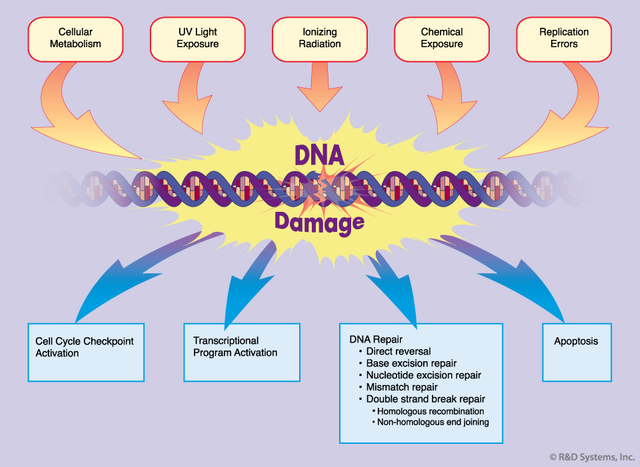Could our own DNA repair mechanisms be used to cure cancers?
There are around 10^13 cells in the human body. The process of DNA replication is by no means error free and there are on average 100,000 DNA lesions per cell per day. Consequently, 10^18 DNA repair events need to occur per person per day in a relatively error free mechanism in order to ensure that we do not get cancer (https://steemit.com/science/@ovij/why-do-we-get-cancer). It is these repair events that are the focus of this article. Could these repair mechanisms be put to therapeutic use by using drugs to target specific cancers?
Types of DNA repair mechanisms

There are numerous ways that DNA can become damaged (as shown above), but there are also ways that our own cells can combat this damage, whether that be through repairing the damage or through apoptosis. DNA repair events are critical to ensuring the number of errors in replication are kept at a minimum and thus cancer rates are relatively low.
There are two major types of DNA repair mechanism depending on whether one or both strands of DNA (https://steemit.com/science/@ovij/what-is-dna-why-do-we-need-it) are damaged. The single strand repair mechanism has three major subtypes: base excision repair, nucleotide excision repair and mismatch repair. In each of these cases the basis for repair is the recognition of the incorrect or damaged base, filling the gap using a DNA polymerase, followed by a DNA ligase sealing the gap. Double stranded repair mechanisms have two major types of DNA repair: homologous recombination and non-homologous end joining.
Damaged DNA repair mechanisms causing disease
Inherited mutations in the genes encoding for nucleotide excision repair are associated with the genetic disease xeroderma pigmentosum. The symptoms of xeroderma pigmentosum include extreme sensitivity to sunlight, premature skin ageing and a predisposition to skin cancers. Furthermore, mutations in the mismatch repair system are linked with an inherited predisposition to cancer, especially a type of hereditary colorectal cancer called nonpolyposis colorectal cancer syndrome.
Using DNA repair mechanisms to combat cancer
The idea of exploiting the various pathways of DNA repairs as potential drug targets for cancer therapy has become a very active and promising area of research. Although the concept of targeting cellular mechanisms that maintain genomic stability could appear counterintuitive, the approach is built on the observation that cancer cells often inactivate some of their own DNA repair mechanisms and start to rely solely on a small set of DNA repair mechanisms. By attacking these specific pathways, it is possible to induce cancer cell death, while causing only minor harm to healthy cells, since these cells have access to all the possible DNA repair mechanisms (that are described above). This concept of synthetic lethality has been successfully exploited for the first time with the drug Olaparib, which treats breast cancer. Perhaps more drugs could use the idea of synthetic lethality to combat each specific cancer. This may provide more specialised and effective treatments to cancer in the future.
Further reading:
For more detail on DNA repair mechanisms https://www.khanacademy.org/science/biology/dna-as-the-genetic-material/dna-replication/a/dna-proofreading-and-repair
References:
Image 1: https://www.rndsystems.com/resources/articles/dna-damage-response
Got a really interesting post here. I like the others you wrote aswell so much I didnt know.
So Id like to nominate this one in a curation group im in
This gem of a post was discovered by the OCD Team!
Reply to this comment if you accept, and are willing to let us share your gem of a post! By accepting this, you have a chance to receive extra rewards and one of your photos in this article may be used in our compilation post!
You can follow @ocd – learn more about the project and see other Gems! We strive for transparency.
You are welcome to share this post!!!
DNA repairing can only go till certain point when other factors kicks in that prevent further repairing.
Nice post~ upvote and followed
I agree, if the damage is too extensive then apoptosis has to occur. However the evasion of apoptosis is one of the hallmarks of cancer and trying to stop this evasion is another avenue of treatment for many cancers. I'm glad you enjoyed the post!
good post! based on what i know it is very difficult to detect cancer specially in the beginning. i think this method of repairing damaged cancer can work only when there is a few cancer cells ( beginning of cancer ) but when you have a tumor .. you can't repair in this case you'll have destroy cancer cells
Interesting. Upvoted an following.
I was gonna upvote it but the system is not letting me because it's past 7 days already. Anyhoo, I like what you wrote because I know some people who died coz of cancer. If our DNA can really cure cancers, then that's awesome because we can prolong the lives of many including my grand parents. :)
Thank you, I'm glad that you found the post interesting and informative
I upvoted your comment. I learned that you can still earn by upvoting comments. Good job on your article! :))